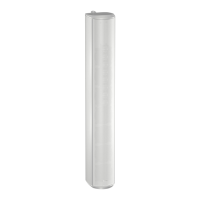10 VLS Series Speakers Quick Start Guide 11
Connectors and cabling
VLS Series loudspeakers are connected to the ampli er (or to other loudspeakers in a 70/100 V system or series/parallel con guration) using a pair of internally
paralleled barrier strip connectors.
All VLS Series models can be operated as either a low impedance loudspeaker or within a 70/100 V distributed system. The operation mode is selectable via a single
switch located on the rear of the cabinet (see below).
Operation in low impedance mode often will require use of larger diameter cables than are needed for a 70/100 V distributed system. Please consult the full
VLS Operation Manual for recommended cable types for various applications.
Switch for Low-Z and transformer tap selection
A multi-position rotary switch on the rear input panel selects either the low-impedance operating mode or the high-impedance modes (70 V or 100 V) with available
transformer taps. When using VLS Series loudspeakers in distributed line systems, the transformer can be tapped with available power levels shown in the
table below:
All transformer primaries should be connected in parallel to the output of the ampli er. The summed total power rating in watts of the selected tap settings for all
connected loudspeakers must not exceed the total output power rating of the connected ampli er output channel in watts. It is recommended that a generous power
safety margin (minimum 3 dB headroom) be maintained between the total loudspeaker power requirements and the ampli er output capacity to avoid continuous
ampli er operation at full rated output.
70 V 100 V
5 W 9.5 W
9.5 W 19 W
19 W 37.5 W
37.5 W 75 W
75 W 150 W
150 W —
Wiring the connectors
Low Impedance (8 ohm) Mode
If connecting directly to the ampli er in low impedance mode, connect the positive (+) conductor to a positive (+) barrier strip terminal and the negative (–)
conductor to a negative (–) terminal. It is preferable to connect several loudspeakers to one ampli er output in parallel, series, or series/parallel con gurations using
the other internally paralleled barrier strip connector.
For more information on this, please consult the full VLS Series Operation Manual.
Constant voltage (70 V / 100 V) Mode
In constant voltage distributed systems, normally a number of loudspeakers are connected in parallel to a single ampli er output. Connect the positive (+) conductor
from the ampli er or prior loudspeaker in the system to a positive (+) barrier strip terminal and the negative (–) conductor to a negative (–) terminal. The other
parallel barrier strip is available for connecting additional loudspeakers.
Outdoor Applications
A right angled water tight cable gland is supplied with the VLS 7 (EN 54) and VLS 15 (EN 54) for use in outdoor applications (Fig.1). The VLS 30 has an input panel cover
with rubber wiring grommet for use in outdoor applications (Fig.2). Before making connections, pass the wire(s) through the cable grand/rubber grommet. The input
panel cover is secured to the cabinet using the four screws already inserted around the input.
Asymmetric vertical pattern: mounting and ying
VLS Series loudspeakers are designed with an asymmetrical vertical dispersion pattern, a feature which allows improved performance with simpli ed mounting in
many applications. The vertical dispersion of the VLS 7 (EN 54) and VLS 15 (EN 54) models is +6/-22 degrees from center axis, while the pattern of the VLS 30 is +3/-11
degrees from center axis.
Please be aware of this feature when planning your installation. In many situations where conventional column loudspeakers would require substantial downward tilt,
a VLS Series loudspeaker would require less tilt or even allow ush mounting, thus providing a simpler installation with improved visual aesthetics.

